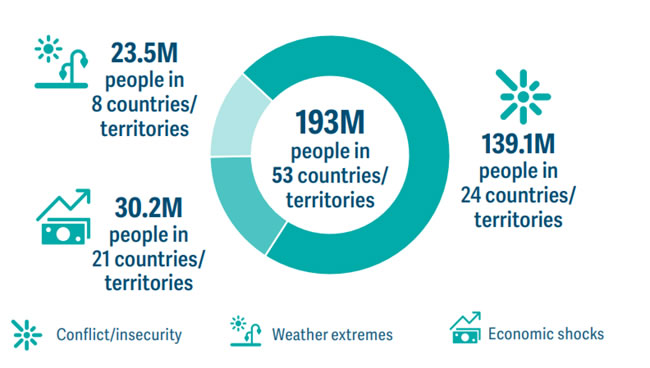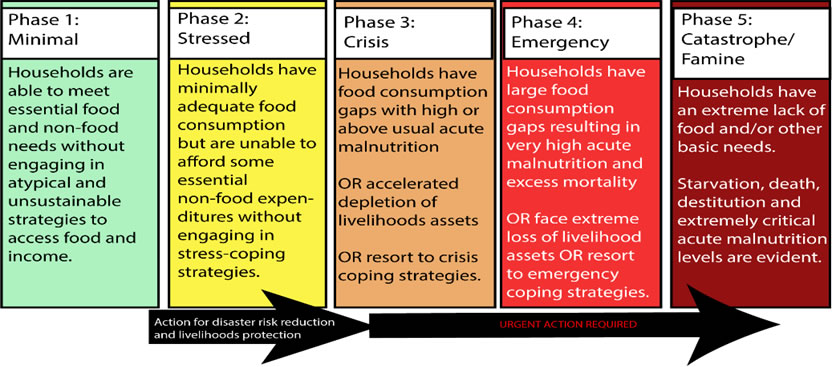and the threat of Infectious Outbreaks
The recently published, Global Report on Food Crisis [1] confirmed that close to 193 million people in 53 countries/territories are now in a food crisis or worse (IPC/CH Phase 3 or above: Figure 1). Food crisis levels are persistently driven by conflict, climate change and population displacement. The number of people facing food shortages is nearly double the 2016 calculated number of 108 million people who were acutely food insecure and in need of assistance across 48 countries.
According to the WFP (World Food Programme) HungerMap, as of June 14, 2022, 861 million people across 91 countries do not have sufficient food on a daily basis, many will go to bed hungry2. The reasons for this food shortage increase are multifaceted. Scarcity of food and water, rising wheat and fuel prices, lack of medicines, the damaging consequences of the COVID-19 pandemic, rising global temperatures and conflict escalated crises, all exacerbate the situation.

Of the main drivers, conflict and insecurity remains at the forefront and the key driver in many countries such as Ethiopia, South Sudan, and Yemen, where food crisis is classed as catastrophe, meaning households have an extreme lack of food/basic needs. Exacerbated by critical malnutrition levels, communities are on the brink of famine. Frequent and recurring floods, droughts, hurricanes and cyclones have also been projected to continue to cause economic shocks from June to September this year, which will be devastating for all concerned.
Conflict will continue to compromise the food security of those directly affected by war but also compound the challenges faced by acutely insecure people across the world. Another worry with regard to ongoing conflict are infectious diseases. Emerging infectious disease can be defined as infectious diseases that have newly appeared in a population or have existed and are rapidly increasing in incidence3. Conflict situations can lead to large displacements of populations, leading to overcrowdings, inadequate safe water, lack of sanitisation, and exposure to disease vectors4. The long-term stress associated with such conditions can lead to vulnerable populations.
The detection and control of emerging infectious diseases, in these conflict-stricken climates, is a major challenge. Historically, poor infection control practices during conflict have led to the emergence of infections that were virtually eliminated (e.g., Malaria infection due to civil strife led to an estimated 200,000-500,000 cases in 19974 or the Cholera outbreak which has plagued Haiti since the 2010 earthquake5). The emerging infectious diseases that are of greatest concern today include Tuberculosis, hepatitis, vector-born and water-borne diseases6.
The World Health Organization (WHO) has established a programme of Communicable Diseases in Complex Emergencies to help combat infection prevention in crisis-affected populations. Key infection control precautions remain standard, despite the circumstances, and include transmission-based precautions such as contact by droplets or airborne diseases, as well as hand hygiene, Personal Protective Equipment (PPE) and environmental cleaning.

At Aquatabs, we continue to focus on delivering cost-effective, innovative, WASH NUTRITION solutions. In collaboration with Nutriset, we provide an integrated approach to reduce the risk of diarrhoea, parasitic infections and intestinal inflammations (or environmental enteric dysfunction) and improve nutritional impact.
“Studies show that introducing Point of Use water treatment such as Aquatabs® to a nutrition intervention improve the recovery rates from Severe Acute Malnutrition by 16.7% to 22.2%.”

The Aquatabs WASH KIT brings together all the infection prevention items needed to disinfect a rural healthcare facility. That's all the water, hand, surface and medical instrument disinfection requirements in one box for an entire year. Find out more about our products on our website or contact Robert Cooper for more details.
https://youtu.be/lh09LiEzi5M
References:
1 https://www.wfp.org/publications/global-report-food-crises-2022
2 https://hungermap.wfp.org/
3 https://www.niaid.nih.gov/research/emerging-infectious-diseases-pathogens#:~:text=Emerging%20infectious%20diseases%20can%20be,B%2C%20or%20C%20priority%20pathogens
4 Gayer M, Legros D, Formenty P, Connolly MA. Conflict and emerging infectious diseases. Emerg Infect Dis. 2007;13(11):1625-1631. doi:10.3201/eid1311.061093
5 https://ghss.georgetown.edu/idconflict/#
6 https://www.escmid.org/fileadmin/src/media/PDFs/3Research_Projects/EITaF/EITaF_2022_06_01.pdf

